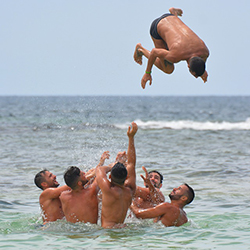 In recent years, team building has gained a foothold in corporate America as a fun and effective management tool. To be successful in the business world, employees must be able to effectively plan and execute programs as a team, communicate clearly, use resources efficiently, and be able to adapt to changing circumstances.
In recent years, team building has gained a foothold in corporate America as a fun and effective management tool. To be successful in the business world, employees must be able to effectively plan and execute programs as a team, communicate clearly, use resources efficiently, and be able to adapt to changing circumstances.
Team building is designed to do utilize these skills, in a fun environment. It can encourage out-of-the box thinking and enhance group dynamics, breaking down barriers that prevent employees from working together as a team. Activities foster decision-making, challenge resolution and leadership skills.
Exercises can be designed to encourage individuals in a group to entrust their safety in one another or to experience the exhilaration of overcoming a physical challenge. Participants return to work infused with renewed vigor. The goal is to transfer the collaborative effort, positive energy and learning that take place during a team-building activity back into the workplace.
But team building can also be a risk manager’s nightmare when activities include dangerous physical elements. Companies must consider the risks involved in such hazardous activities. They can lead to an increase in the frequency and severity of employee injuries, leaving the company vulnerable to higher workers’ compensation costs – not to mention employee lawsuits.
If team-building activities are part of your company’s management philosophy for bringing employees together to work cohesively as a group, make certain that safety is part of the equation. Consultants brought in to design such programs should know your expectations and concerns and abide by them. A company in Miami that hired a consultant for team building found that a dozen or so of its 100 employees suffered 1st and 2nd degree burns when they were forced to engage in a firewalk. The consultant called the injury rate “acceptable.”
Activities such as white water rafting, rock climbing, and paintball might not be suitable for all employees. Besides the physical hazards, planners need to consider whether or not an activity might be embarrassing for some employees. An activity that requires participants to wear a bathing suit, for example, might make some employees self-conscious and inhibit their ability to fully engage in the collaborative effort.
To promote safe team building:
Emphasize the need to exercise caution on the job and in any physical team-building exercise.
Define your needs clearly to management consultants, hired to design a team-building program.
Ensure team-building activities are properly supervised.
Stop any activity if an unsafe situation is observed.
Team building has an important place in business. Activities should focus on bringing employees together. Make team building a safe experience that everyone can participate in and enjoy.





